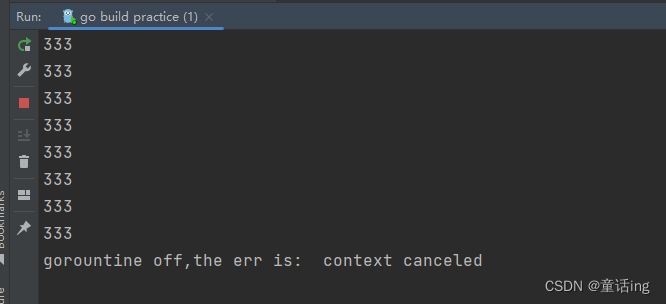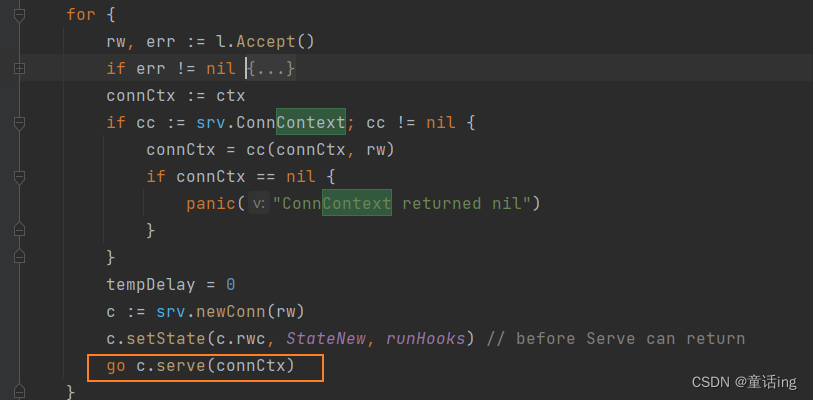golang中http请求的context传递到异步任务的坑及解决
前言
在golang中,context.Context可以用来用来设置截止日期、同步信号,传递请求相关值的结构体。 与 goroutine 有比较密切的关系。
在web程序中,每个Request都需要开启一个goroutine做一些事情,这些goroutine又可能会开启其他的 goroutine去访问后端资源,比如数据库、RPC服务等,它们需要访问一些共享的资源,比如用户身份信息、认证token、请求截止时间等 这时候可以通过Context,来跟踪这些goroutine,并且通过Context来控制它们, 这就是Go语言为我们提供的Context,中文可以理解为“上下文”。
简单看一下Context结构
type Context interface {
Deadline() (deadline time.Time, ok bool)
Done() <-chan struct{}
Err() error
Value(key interface{}) interface{}
}
- Deadline方法是获取设置的截止时间的意思,第一个返回值是截止时间,到了这个时间点,Context会自动发起取消请求; 第二个返回值ok==false时表示没有设置截止时间,如果需要取消的话,需要调用取消函数(CancleFunc)进行取消。
- Done方法返回一个只读的chan,类型为struct{},在goroutine中,如果该方法返回的chan可以读取,则意味着parent context已经发起了取消请求, 我们通过Done方法收到这个信号后,就应该做清理操作,然后退出goroutine,释放资源。之后,Err 方法会返回一个错误,告知为什么 Context 被取消。
- Err方法返回取消的错误原因,Context被取消的原因。
- Value方法获取该Context上绑定的值,是一个键值对,通过一个Key才可以获取对应的值,这个值一般是线程安全的。
常用的
// 传递一个父Context作为参数,返回子Context,以及一个取消函数用来取消Context。
func WithCancel(parent Context) (ctx Context, cancel CancelFunc)
// 和WithCancel差不多,它会多传递一个截止时间参数,意味着到了这个时间点,会自动取消Context,
// 当然我们也可以不等到这个时候,可以提前通过取消函数进行取消。
func WithDeadline(parent Context, deadline time.Time) (Context, CancelFunc)
// WithTimeout和WithDeadline基本上一样,这个表示是超时自动取消,是多少时间后自动取消Context的意思
func WithTimeout(parent Context, timeout time.Duration) (Context, CancelFunc)
//WithValue函数和取消Context无关,它是为了生成一个绑定了一个键值对数据的Context,
// 绑定的数据可以通过Context.Value方法访问到,这是我们实际用经常要用到的技巧,一般我们想要通过上下文来传递数据时,可以通过这个方法,
// 如我们需要tarce追踪系统调用栈的时候。
func WithValue(parent Context, key, val interface{}) Context
HTTP请求的Context传递到异步任务的坑
看下面例子
我们将http的context传递到goroutine 中:
package main
import (
"context"
"fmt"
"net/http"
"time"
)
func IndexHandler(resp http.ResponseWriter, req *http.Request) {
ctx := req.Context()
go func(ctx context.Context) {
for {
select {
case <-ctx.Done():
fmt.Println("gorountine off,the err is: ", ctx.Err())
return
default:
fmt.Println(333)
}
}
}(ctx)
time.Sleep(1000)
resp.Write([]byte{1})
}
func main() {
http.HandleFunc("/test1", IndexHandler)
http.ListenAndServe("127.0.0.1:8080", nil)
}
结果:

从上面结果来看,在http请求返回之后,传入gorountine的context被cancel掉了,如果不巧,你在gorountine中进行一些http调用或者rpc调用传入了这个context,那么对应的请求也将会被cancel掉。
因此,在http请求中异步任务出去时,如果这个异步任务中需要进行一些rpc类请求,那么就不要直接使用或者继承http的context,否则将会被cancel。
纠其原因
http请求再结束后,将会cancel掉这个context,所以异步出去的请求中收到的context是被cancel掉的。
下面来看下源代码:
ListenAndServe–>Server:Server方法中有一个大的for循环,这个for循环中,针对每个请求,都会起一个协程进行处理。

serve方法处理一个连接中的请求,并在一个请求serverHandler{c.server}.ServeHTTP(w, w.req)结束后cancel掉对应的context:
// Serve a new connection.
func (c *conn) serve(ctx context.Context) {
c.remoteAddr = c.rwc.RemoteAddr().String()
ctx = context.WithValue(ctx, LocalAddrContextKey, c.rwc.LocalAddr())
defer func() {
if err := recover(); err != nil && err != ErrAbortHandler {
const size = 64 << 10
buf := make([]byte, size)
buf = buf[:runtime.Stack(buf, false)]
c.server.logf("http: panic serving %v: %v\n%s", c.remoteAddr, err, buf)
}
if !c.hijacked() {
c.close()
c.setState(c.rwc, StateClosed, runHooks)
}
}()
if tlsConn, ok := c.rwc.(*tls.Conn); ok {
if d := c.server.ReadTimeout; d != 0 {
c.rwc.SetReadDeadline(time.Now().Add(d))
}
if d := c.server.WriteTimeout; d != 0 {
c.rwc.SetWriteDeadline(time.Now().Add(d))
}
if err := tlsConn.Handshake(); err != nil {
// If the handshake failed due to the client not speaking
// TLS, assume they're speaking plaintext HTTP and write a
// 400 response on the TLS conn's underlying net.Conn.
if re, ok := err.(tls.RecordHeaderError); ok && re.Conn != nil && tlsRecordHeaderLooksLikeHTTP(re.RecordHeader) {
io.WriteString(re.Conn, "HTTP/1.0 400 Bad Request\r\n\r\nClient sent an HTTP request to an HTTPS server.\n")
re.Conn.Close()
return
}
c.server.logf("http: TLS handshake error from %s: %v", c.rwc.RemoteAddr(), err)
return
}
c.tlsState = new(tls.ConnectionState)
*c.tlsState = tlsConn.ConnectionState()
if proto := c.tlsState.NegotiatedProtocol; validNextProto(proto) {
if fn := c.server.TLSNextProto[proto]; fn != nil {
h := initALPNRequest{ctx, tlsConn, serverHandler{c.server}}
// Mark freshly created HTTP/2 as active and prevent any server state hooks
// from being run on these connections. This prevents closeIdleConns from
// closing such connections. See issue https://golang.org/issue/39776.
c.setState(c.rwc, StateActive, skipHooks)
fn(c.server, tlsConn, h)
}
return
}
}
// HTTP/1.x from here on.
ctx, cancelCtx := context.WithCancel(ctx)
c.cancelCtx = cancelCtx
defer cancelCtx()
c.r = &connReader{conn: c}
c.bufr = newBufioReader(c.r)
c.bufw = newBufioWriterSize(checkConnErrorWriter{c}, 4<<10)
for {
// 从连接中读取请求
w, err := c.readRequest(ctx)
if c.r.remain != c.server.initialReadLimitSize() {
// If we read any bytes off the wire, we're active.
c.setState(c.rwc, StateActive, runHooks)
}
.....
.....
// Expect 100 Continue support
req := w.req
if req.expectsContinue() {
if req.ProtoAtLeast(1, 1) && req.ContentLength != 0 {
// Wrap the Body reader with one that replies on the connection
req.Body = &expectContinueReader{readCloser: req.Body, resp: w}
w.canWriteContinue.setTrue()
}
} else if req.Header.get("Expect") != "" {
w.sendExpectationFailed()
return
}
c.curReq.Store(w)
// 启动协程后台读取连接
if requestBodyRemains(req.Body) {
registerOnHitEOF(req.Body, w.conn.r.startBackgroundRead)
} else {
w.conn.r.startBackgroundRead()
}
// HTTP cannot have multiple simultaneous active requests.[*]
// Until the server replies to this request, it can't read another,
// so we might as well run the handler in this goroutine.
// [*] Not strictly true: HTTP pipelining. We could let them all process
// in parallel even if their responses need to be serialized.
// But we're not going to implement HTTP pipelining because it
// was never deployed in the wild and the answer is HTTP/2.
serverHandler{c.server}.ServeHTTP(w, w.req)
/**
* 重点在这儿,处理完请求后将会调用w.cancelCtx()方法cancel掉context
**/
w.cancelCtx()
if c.hijacked() {
return
}
w.finishRequest()
if !w.shouldReuseConnection() {
if w.requestBodyLimitHit || w.closedRequestBodyEarly() {
c.closeWriteAndWait()
}
return
}
c.setState(c.rwc, StateIdle, runHooks)
c.curReq.Store((*response)(nil))
if !w.conn.server.doKeepAlives() {
// We're in shutdown mode. We might've replied
// to the user without "Connection: close" and
// they might think they can send another
// request, but such is life with HTTP/1.1.
return
}
if d := c.server.idleTimeout(); d != 0 {
c.rwc.SetReadDeadline(time.Now().Add(d))
if _, err := c.bufr.Peek(4); err != nil {
return
}
}
c.rwc.SetReadDeadline(time.Time{})
}
}
至此,我们知道,http请求在正常结束后将会主动cancel掉context。
此外,在请求异常时候也会主动cancel掉context(cancel目的就是为了快速失败),具体可见w.conn.r.startBackgroundRead() 其中的实现。
在日常开发中,我们知道有时候会存在客户端超时情况,和ctx相关的原因可归纳如下:
- 服务端收到的请求的request context被cancel掉。
- 客户端本身收到context deadline exceeded错误
- 服务端业务业务使用了http的context,但没有用于做rpc等需要建立连接的任务,那么客户端即使收到了context canceled的错误,服务端实际上还是在继续执行业务代码。
- 服务端业务业务使用了http的context,并用于做rpc等需要建立连接的任务,那么客户端收到context canceled错误,并且服务端也会在对应的rpc等建立连接任务处返回context cancled的错误。
最后,如果context cancel掉了,但是业务又在继续执行,有时候并不是我们想要的结果,因为这会占用资源,因此我们可以主动在业务中通过监听context Done的信号来做context canceled的处理,从而可以达到快速失败,节约资源的目的。
总结
以上为个人经验,希望能给大家一个参考,也希望大家多多支持脚本之家。
相关文章

golang中使用proto3协议导致的空值字段不显示的问题处理方案
这篇文章主要介绍了golang中使用proto3协议导致的空值字段不显示的问题处理方案,文中通过示例代码介绍的非常详细,对大家的学习或者工作具有一定的参考学习价值,需要的朋友们下面随着小编来一起学习学习吧2019-10-10
Golang微服务框架Kratos实现Kafka消息队列的方法
消息队列是大型分布式系统不可缺少的中间件,也是高并发系统的基石中间件,所以掌握好消息队列MQ就变得极其重要,在本文当中,您将了解到:什么是消息队列?什么是Kafka?怎样在微服务框架Kratos当中应用Kafka进行业务开发,需要的朋友可以参考下2023-09-09












最新评论